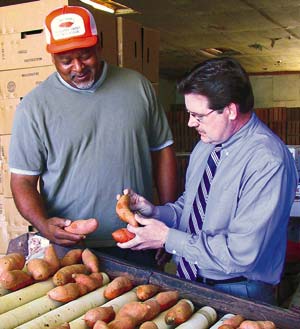Taters For Tots

An estimated half-million Alabama school children were served fresh, Alabama-grown produce this spring, and if State Agriculture Commissioner Ron Sparks has his way, more local produce will be on the menu this fall.This spring, Sparks helped coordinate the first-ever purchase of Alabama produce by the Alabama Department of Education’s Child Nutrition Program. The state purchased 2,000 40-pound boxes of sweet potatoes grown in Cullman County by farmers Mike Fullilove, Joey Stephens, Keith Smith and Brian Kress. The purchase, which totaled $36,000, was picked up from the Fullilove Farm just east of Cullman. Hundreds of boxes stamped “Cullman County Alabama Sweet Potatoes” were loaded onto a truck.The Alabama Department of Agriculture and Industries is working with the U.S. Department of Defense to implement the Farm-to-School Program, which uses federal funds to purchase fresh, locally grown fruits and vegetables for Alabama’s school lunchrooms. Funding for the program was authorized in the 2002 Farm Bill.Perry Fulton, director of the Child Nutrition Program for the Alabama Department of Education, said between a half million and 600,000 children are fed each day through the school lunch program. He said he’d like to see more Alabama-grown food purchased for the program.”This is the first-ever (fresh produce) to be purchased from an Alabama producer,” Fulton said. “The main problem we’ve run into in the past is that when most crops in Alabama are harvested, school is out for the summer. There’s also the issue of quantity–this truckload of sweet potatoes will be used in just one day. So you can see, we need lots of whatever we buy.”The program uses competitive bids to purchase all food used in Alabama school lunchrooms. And while this is the first fresh produce, the program regularly purchases poultry and pork in Alabama.Fulton said he and Sparks are looking at what other foods will be available for the program such as apples and cantaloupes. Another likely candidate for the program in the near future is Satsuma oranges grown in Alabama.”Right now we’re purchasing tangerines from Florida, and we’d much rather have fruit grown by the farmers in our state,” Fulton said. “I had never tasted a Satsuma until recently, and they really are delicious. They’re also really easy for younger children to peel and eat.”Mike Fullilove has been growing sweet potatoes on his farm for 23 years. Usually he plants 130 to 150 acres per year, harvesting 400 bushels per acre in a good year. He said he’s excited about the possibility of a steady additional market for his produce.”Right now we mostly sell to a wholesale company in Atlanta which distributes sweet potatoes to stores and farmers markets throughout the Southeast,” Fullilove said. “With this new market, we may be able to sell the school lunch program other things we grow like watermelons and cantaloupes–at least we hope so.”Brian Hardin, director of the Alabama Farmers Federation’s Horticulture Division said creating new markets is crucial to the success of Alabama agriculture.”Any time a new market can be provided for a farmer’s crop, it’s a plus,” Hardin said. “More market opportunities decrease a farmer’s dependence on one buyer and give him or her more options.””This is the first of what I hope will be many items that are grown in our state that wind up in Alabama school lunchrooms,” Sparks said. “I want Alabama school kids to eat Alabama sweet potatoes and other Alabama products.”Alabama ranks fifth in the nation in sweet potato production, with cash receipts of $8.3 million in 2001, when farmers harvested 2,900 acres of sweet potatoes.
